
Feature Article
“Superbugs” in Food
Antimicrobial resistance (AMR) is a threat to global health that necessitates quick cross-sectoral responses, including those from people involved in the food industry because food, especially food animals, can be sources of and vehicles for the spread of AMR microorganisms. The rapid spread of multidrug-resistant bacteria, or “superbugs”, which cause infections with few or no available antimicrobials for treatment, is of special concern. In this article, we will discuss the finding of “superbugs” in food and what we can do to lower the risk of contracting them.
Monitoring and Surveillance of “Superbugs” in Food
People are exposed to AMR microorganisms through a variety of sources, including other people, contaminated food, water, animals, and the environment. Under the “One Health Approach”, thanks to an integrated monitoring and surveillance system, data comparison across sectors and comprehensive analyses to ascertain the contribution of various sources to the actual burden of AMR in human diseases is possible, which can support evidence-based measures.
For food safety components, the system covers foodborne AMR, which includes collection of data for risk analysis, as well as trend analysis, epidemiological studies, food source attribution studies and research. In general, the detection of AMR microorganisms will not be handled in the same way as that of pathogens in food poisoning cases, but more in a way of collating data for analysis of the whole picture followed by taking proportional risk management action. In addition, it is important to determine under the integrated system if there is a change in AMR among human infections in response to the change in foodborne AMR. Such information is very important for the formulation of a strategy to tackle AMR.
To determine the state of foodborne AMR, food samples are gathered for analysis of bacteria, both pathogenic and commensal. A more sensitive method is used to identify “superbugs”, which are infrequently discovered by random sampling. This is accomplished by using a particular antibiotic to screen collected samples for specific “superbugs”, and other bacteria that are not “superbugs” will be killed by the antibiotic. As a result, even though they are present in very small amounts, targeted “superbugs” like extended-spectrum b-lactamase (ESBL)-producing and carbapenem-resistant Enterobacteriaceae can be detected. ESBLs have resistance to critically important antimicrobial drugs, and bacteria carrying such resistant trait must be treated with antibiotics of last resort, like carbapenem antibiotics. Yet, resistance to carbapenem is on the rise too. As such, it is very important to keep an eye on the trends of these “superbugs”, for example, increase in the prevalence of specific strains or the genes with resistant traits.
Risk of “Superbugs” in Ready-to-eat Food
To track foodborne AMR near the end of the food chain, ready-to-eat food can be collected in addition to animal products. The risk posed by ready-to-eat food containing “superbugs” depends on whether the “superbugs” are foodborne pathogens, i.e. those causing diseases through the consumption of food. For “superbugs” that are foodborne pathogens, symptoms of infections are similar to those caused by pathogens that can be killed or inhibited by antibiotics but the infections may be difficult to treat in serious cases. On the other hand, no matter whether the “superbug” found is pathogenic or not, there is a possibility of the spread of AMR genes to other bacteria in the human gut. However, determining how frequently this occurs is difficult because gene transfer is a random occurrence and bacteria do not always stay in the body. There is currently no conclusive evidence that long-term consumption of food contaminated with “superbugs” will result in an increased range of AMR in a person. Nevertheless, exposure to AMR microorganisms should be minimised, particularly for vulnerable populations who are more susceptible to foodborne diseases.
How to Avoid “Superbugs” in Food?
The rise in foodborne AMR will undoubtedly increase the risk of contracting AMR bacteria, but our action should not hinge on whether or not bacteria are resistant. The contamination of food may occur from farm to fork as AMR microorganisms, like foodborne pathogens, exist in the environment. To reduce the risk of contracting both “superbugs” and foodborne pathogens, we should adhere to the “5 Keys to Food Safety” in our everyday lives. On the other hand, susceptible populations such as pregnant women, infants and young children, the elderly and people with weakened immunity (i.e. people with chronic diseases or those on antibiotics treatment, antacid and long-term steroids or drugs given to prevent transplant rejection, etc.) are of a higher risk and should therefore avoid eating raw or undercooked ready-to-eat food that has not been sufficiently cooked to kill “superbugs” and foodborne pathogens.

Figure: Combating “superbugs” with “5 Keys to Food Safety”
Mascot ON in Lesson
1. Frozen Processed Food – Can It be Eaten Directly after Defrosting?
Recently, it was suggested in an online discussion group that defrosted frozen pizzas tasted better without reheating.
Frozen processed food is not necessarily ready to eat after defrosting. Even though some frozen pizzas have browned crust, frozen meat patties have grill marks, or others have traits that are visually associated with cooked food, the sheer look of the frozen products cannot guarantee that they are ready to serve after defrosting. While these food products may have been partially cooked in factories to shorten the cooking time at home, the temperature in the cooking process may not be high enough to thoroughly cook the food and eliminate all disease-causing bacteria. Some bacteria not killed in the partial cooking process can survive freezing, and only thorough cooking can kill them.
Therefore, when purchasing and preparing frozen processed food, one should carefully read the labels and follow the preparation instructions, including the cooking time and temperature, in order to make the food safe to eat.
2. Food Safety Risks of Cross-Boundary Meal Delivery
With the resumption of normal economic and social activities, more people are turning to cross-boundary meal delivery services as a convenient and alternative food option. However, meal delivery over long distances may trigger bacterial overgrowth if there is no proper control on the food storage temperature and delivery time, making the food prone to spoilage during delivery. Bacteria that cause food poisoning will thrive and multiply rapidly within the temperature danger zone between 4oC and 60oC. Consuming contaminated food could lead to food poisoning.
To ensure food safety, hot food and cold food should be kept at above 60oC and at or below 4oC respectively. If the food is kept within the temperature danger zone, the two-hour and four-hour principle should be followed (i.e. if prepared food is kept at room temperature for less than two hours, it can be refrigerated for later use; if cooked food has been held at room temperature for more than four hours, it should be discarded) to prevent bacterial growth.
Spot Check
1. Soaking Mushrooms and Food Safety
Dried mushrooms such as wood ear, jelly fungus and flower mushroom are widely used in dish preparation. It is common to soak dried mushrooms in water before using them in a dish. Soaking them will increase their water content, and prolonged soaking at room temperature could lead to proliferation of bacteria. Some of these bacteria are disease-causing that could lead to foodborne illnesses, and some can even produce toxins.
Upon preparation, wash dried mushrooms under clean running water before transferring them to a clean container for soaking. Avoid soaking too many mushrooms at a time. The time for soaking mushrooms at room temperature generally should be no more than two hours, otherwise they should be kept in the refrigerator. Soaked mushrooms should be cooked and consumed as soon as possible. Discard mushrooms if slime is found on the surface or there is abnormal smell after soaking.
2. Mouldy Food and Food Safety
The warm and humid weather in spring promotes mould growth. Leaving food and leftovers uncovered at room temperature could cause contamination of food by mould spores from the surroundings and mould germination. Mould spores are ubiquitous. Not only can mould cause food spoilage and affect food quality, some of them can even produce toxins that cause illnesses.
Proper food storage can reduce food contamination by spores and inhibit mould growth. Leftovers and unfinished food in opened cans should be transferred to a clean container for refrigeration and consumed as soon as possible. Dried food that requires no refrigeration should be kept in a cool and dry place. Consumers should also avoid overstocking. It is worth noting that removing the mould and the surrounding food materials may help remove the toxins present, but hyphae of the mould can invade deeply into the food, so there is no guarantee that all mould and toxins can be removed. For food safety’s sake, mouldy food must not be eaten but thrown away.
Safe Kitchen/Trade Talks/Food Safety Guidelines
Safe Kitchen
Introduction to “Safe Kitchen” Scheme
To facilitate the adoption of Five Keys to Food Safety and Good Hygiene Practices (GHPs) by trade members, and enhance food safety in their daily operation, the Centre for Food Safety (CFS) has integrated the existing channels of risk communication and launched a new platform, namely “Safe Kitchen”, to communicate with the trade. The platform provides food safety information of greater practical importance to meet the operational needs of catering outlets.
The “Safe Kitchen” platform disseminates up-to-date food safety information (including food safety guidelines and relevant legislative amendments) to the trade through a host of channels including WhatsApp, emails and dedicated websites. In response to food poisoning outbreaks in restaurants, the platform will also issue food alerts to remind the trade of the points to note in preventing future occurrences so that the risk of food poisoning can be minimised.
New dedicated websites and risk information exchange platforms will be rolled out under the “Safe Kitchen” Scheme. In addition, training materials tailor-made for the trade and workshops for kitchen staff will be provided to enhance food safety and hygiene awareness among them. Members of the trade are welcome to scan the relevant QR code below to download the registration form for the “Safe Kitchen” Scheme in order to receive the latest food safety information in a timely manner.

Safe Kitchen/Trade Talks/Food Safety Guidelines
Safe Kitchen
Introduction to "Safe Kitchen" Scheme
To facilitate the adoption of the Five Keys to Food Safety and GHPs by trade members, and enhance food safety in their daily operation, the CFS has integrated the existing channels of risk communication and launched a new platform, namely "Safe Kitchen", to communicate with the trade. The platform provides food safety information of greater practical importance to meet the operational needs of catering outlets.
The "Safe Kitchen" platform disseminates up-to-date food safety information (including food safety guidelines and relevant legislative amendments) to the trade through a host of channels including WhatsApp, emails and dedicated websites. In response to food poisoning outbreaks in restaurants, the platform will also issue food alerts to remind the trade of the points to note in preventing future occurrences so that the risk of food poisoning can be minimised.
New dedicated websites and risk information exchange platforms will be rolled out under the "Safe Kitchen" Scheme. In addition, training materials tailor-made for the trade and workshops for kitchen staff will be provided to enhance food safety and hygiene awareness among them. Members of the trade are welcome to scan the QR code at the side to download the registration form for the "Safe Kitchen" Scheme in order to receive the latest food safety information in a timely manner.

Food Safety Guidelines
1. General Hygiene Advice for Food Businesses — Ready-to-eat Food

Ready-to-eat foods are foods that have been prepared so that they can be eaten without further cooking. Sandwiches, salad greens, pre-cooked meat (such as siu mei and lo mei) as well as food cooked ahead of time to serve cold are intrinsically high-risk since there is no or insufficient heat treatment to eradicate bacteria that can pose dangers to human health.
If hygiene practices are not observed when handling ready-to-eat foods, it may help spread “superbugs” apart from posing the risk of foodborne pathogens. “Superbugs” are microbes that have developed AMR which can prevent a wide range of antimicrobial agents, such as antibiotics, from functioning against them. As a result, they make infections more difficult to treat.
In view of this, the CFS has compiled a new set of guidelines on handling ready-to-eat foods for food businesses’ reference. For details, please visit the following homepage or scan the relevant QR code:
https://www.cfs.gov.hk/english/multimedia/multimedia_pub/files/Full-RTE_Food-Eng_Pamphlet.pdf

2. Food Safety Guidelines for Food Businesses – Siu Mei and Lo Mei
While both siu mei and lo mei are ready-to-eat foods that require no futher cooking before consumption, their preparation processes are vastly different. Recently, the CFS has complied new “Food Safety Guidelines for Food Businesses” regarding these the two local delicacies. To learn more about the common food safety problems related to siu mei and lo mei, food safety measures for producing and selling siu mei and lo mei, and the CFS’s advice on personal and environmental hygiene for food handlers, please click the following link or scan the relevant QR code.
- “Food Safety Guidelines for Food Businesses – Siu Mei”


- “Food Safety Guidelines for Food Businesses – Lo Mei”


News on CFS
1. Enhanced Exchanges on Food Safety between Hong Kong and Macao
To enhance interaction and exchanges on food safety work between Hong Kong and Macao, representatives from the Department of Food Safety of the Municipal Affairs Bureau of the Macao Special Administrative Region participated in the 81st meeting of the Trade Consultation Forum held by the CFS on 23 June 2023.

The CFS also arranged an experience sharing session after the forum for representatives from both sides to gain a deeper understanding of each other’s daily operations in respect of risk communication and food import and export control. The CFS hoped that through close communication and co-operation, both sides would exchange information on food safety more effectively and safeguard food safety together.
2. The 81st Meeting of the Trade Consultation Forum
The 81st meeting of the Trade Consultation Forum was held on 23 June 2023. The CFS and the trade exchanged their views on topics including “Salt Iodisation – A Practical Guide for Salt Importers/Wholesalers/Retailers”, “Implementation of the New Arrangement for Extension of Fresh Food Imported via Hong Kong-Zhuhai-Macau Bridge”, “Safety Assessment of Cultured Meat”, “Export of Food to the Mainland” and “Import Control of Japanese Food”. For details of the event, please visit the following website:
https://www.cfs.gov.hk/english/committee/Notes_and_Presentation_Materials_TCF81_20230623.html
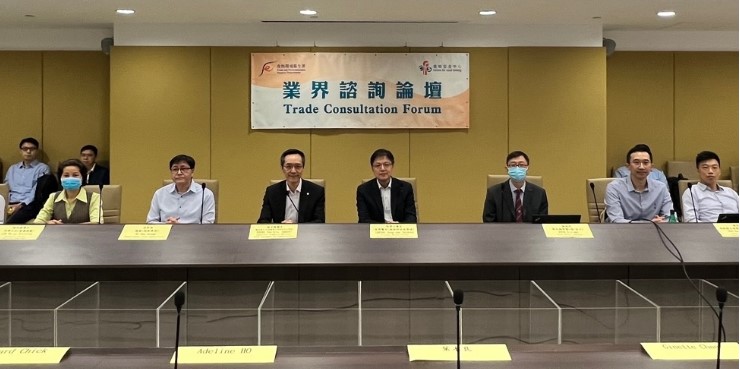
3. CFS's Distribution of New Food Safety Guidelines on Ready-to-eat Foods to Restaurants
Ready-to-eat foods are foods that have been prepared so that they can be eaten without further cooking. Sandwiches, salad greens, pre-cooked meat (such as siu mei and lo mei) as well as food cooked ahead of time to serve cold are intrinsically high-risk since there is no or insufficient heat treatment to eradicate the bacteria that can pose dangers to human health. In view of this, the CFS has compiled new guidelines for food businesses’ reference:
- “General Hygiene Advice for Food Businesses – Ready-to-eat Food”
- “Food Safety Guidelines for Food Businesses – Siu Mei”
- “Food Safety Guidelines for Food Businesses – Lo Mei”
In addition, to enhance food handlers’ understanding of the new guidelines, apart from distributing the guidelines to restaurants, health inspectors also explained the guidelines to restaurant staff and reminded them of the necessary food safety measures for the production of ready-to-eat foods such as siu mei and lo mei.
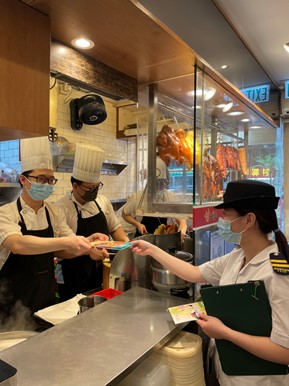
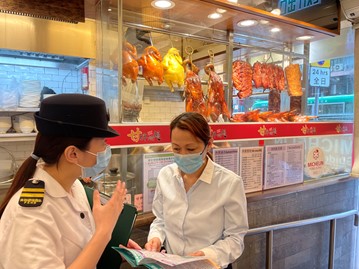
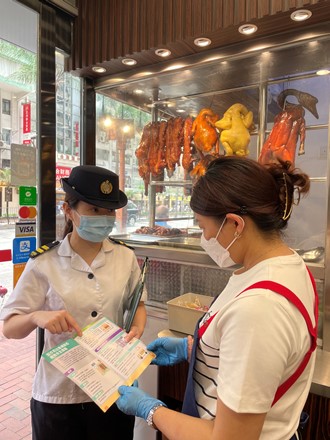
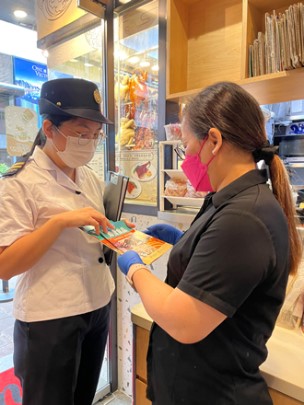
4. “Safe Food at School” Webinar Organised by CFS
Since the resumption of whole-day face-to-face classes, the CFS has stepped up its territory-wide inspections of licensed food factories which supply school lunch boxes with a view to ensuring food safety. To prepare for the start of the new school term, the CFS held on 28 July 2023 an online talk for primary schools, highlighting food safety hazards such as choking and food allergies that school staff and food handlers should pay attention to. In addition, an online trade meeting was held on 2 August 2023 to remind lunch box suppliers to adhere to GHPs in food preparation and establish a food safety plan based on the Hazard Analysis and Critical Control Point system to lower the risks of food contamination.


Ask Our Mascots
Codes on Imported Foods from Japan
Codes on Food Packaging Have No Relation to Foods' Origin
Several years ago, rumours had it that “some imported foods from Japan may be labelled as originating from Tokyo, but have codes in front of the expiration date indicating that the food is actually from Fukushima, Gunma, Chiba, Ibaraki or other regions”. This rumor has revived recently. However, the CFS has checked with the relevant government department of Japan and confirmed that the codes on food packaging have no relation to the foods’ origin.
Close Surveillance on Safety of Imported Food
The Government of the Hong Kong SAR will closely monitor the safety of imported food from Japan and assess the related risks to take appropriate corresponding measures. To learn the latest import control arrangements for food from Japan, go and visit: https://shorturl.at/lxzE9.
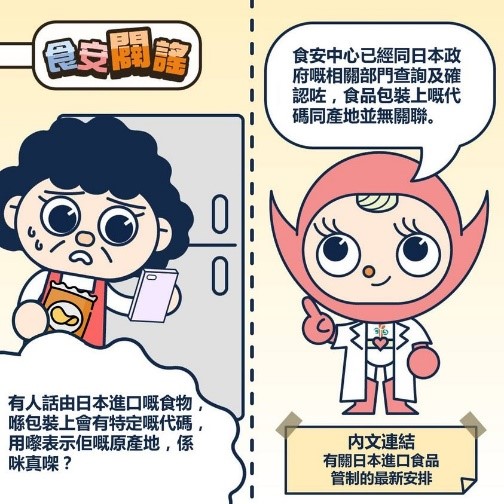
Enhancement Quiz
1. Which of the following is not one of the “Five Keys to Food Safety”?
-
Choose safe raw materials
-
Separate raw and cooked food
-
Cook thoroughly
-
Stay focused
2. What minimum core temperature should be reached for food to be thoroughly cooked as recommended by the CFS?
-
45℃
-
60℃
-
75℃
-
100℃
3. Food must be kept at a safe temperature. Which of the following is outside the safe temperature range?
- Cold food being kept cold at or below 4℃
- Cold food being kept cold at 10℃
- Hot food being kept hot at above 60℃
- Hot food being kept hot at above 70℃
Answers:
1. d
2. c
3. b
Diary of Mascot ON
Prevent Food Poisoning in Summer! Follow “Five Keys to Food Safety”
Bacteria are becoming more active as the weather heats up. In hot summer, the risk of bacterial food poisoning is substantially higher. With the summer approaching, you are reminded to follow the 5 Keys so that you can enjoy seasonal delicacies with peace of mind!
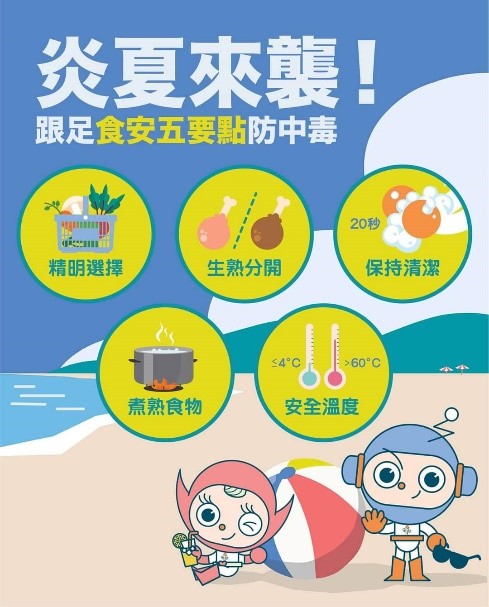
- Choose: Choose safe raw materials – Buy food from reliable shops.
- Clean: Keep hands and utensils clean – Wash hands thoroughly with water and liquid soup for at least 20 seconds before/after preparing food and before eating.
- Separate: Separate raw and cooked food – Use separate knives and chopping boards to handle raw and cooked food.
- Cook: Cook thoroughly – The core temperature of the food should reach at least 75℃.
- Safe temperature: Keep food at a safe temperature – Keep cold food cold at or below 4℃ and hot food hot at above 60℃.
In hot summer, high-risk foods should be handled with extra care and should not be kept at room temperature for a prolonged period of time. Such foods include ready-to-eat foods that generally do not require further cooking (such as siu mei and lo mei, as well as cooked rice and pasta) and raw or undercooked foods (such as oysters and sashimi). To learn more, go and visit the “Safe Food for All” thematic website: https://www.cfs.gov.hk/safefood.